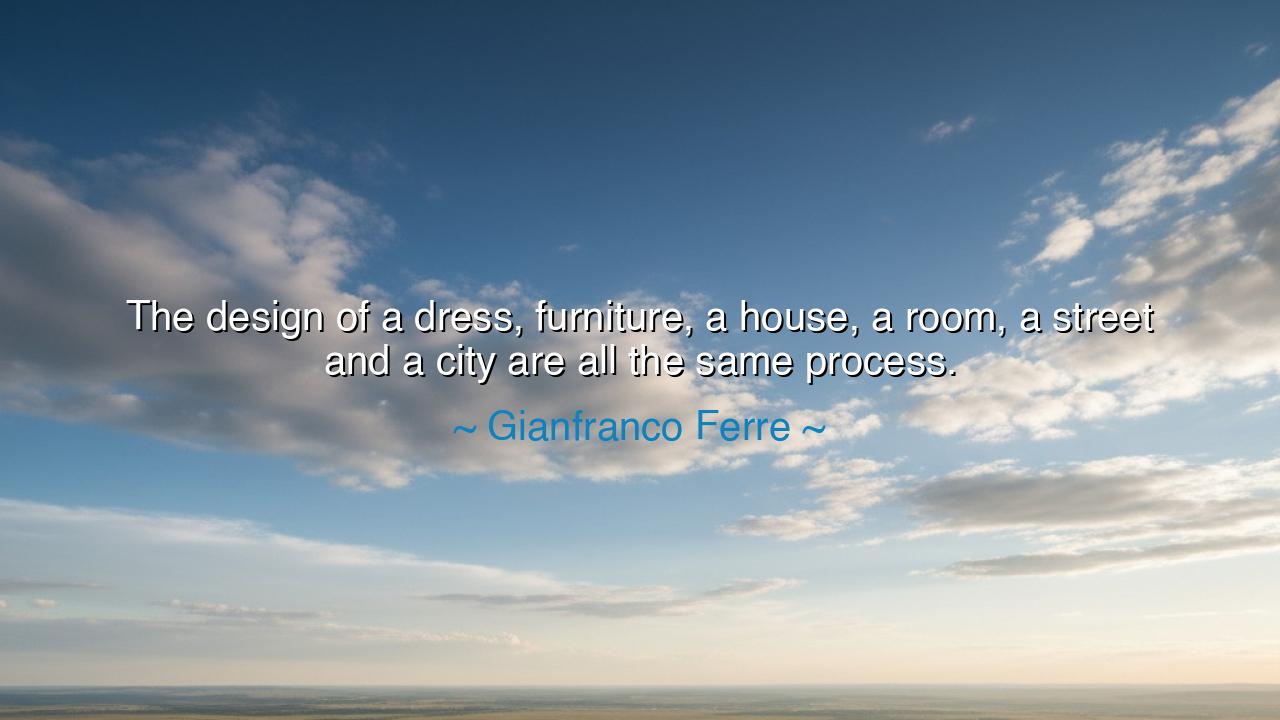
The design of a dress, furniture, a house, a room, a street and a
The design of a dress, furniture, a house, a room, a street and a city are all the same process.






“The design of a dress, furniture, a house, a room, a street and a city are all the same process.” — Gianfranco Ferré
Hear these words, O seekers of beauty and wisdom, and know that they are not merely about design, but about the unity of creation itself. When Gianfranco Ferré, the “Architect of Fashion,” spoke these words, he was not describing a trade, but a truth that underlies all acts of making. He saw what few do: that whether one draws the curve of a gown or the skyline of a city, the process is born from the same sacred impulse—to bring harmony to chaos, to give form to spirit. For the hand that designs is but an instrument of the same divine geometry that shapes the stars and the petals of a flower.
Ferré was first trained as an architect, and so his eyes were schooled in structure, proportion, and order. Yet when he turned to fashion, he did not abandon architecture—he carried it into fabric. His dresses were like cathedrals of silk, built upon invisible scaffolds of geometry. And thus he discovered what all true creators learn: the process of design does not depend on material, but on vision. Whether the medium be cloth or stone, the task remains the same—to balance function with beauty, rhythm with stillness, form with soul.
This truth has been known since the dawn of civilization. Consider Leonardo da Vinci, who drew plans for flying machines with the same hand that painted the Mona Lisa. To him, art and engineering were siblings, born of the same mother—the human imagination. The Greeks too knew this secret. Their temples and tunics alike followed the golden ratio, that eternal measure of balance that pleases the eye because it mirrors the harmony of nature. Thus, Ferré’s insight is ancient as the Parthenon and fresh as morning dew: the act of design—no matter the scale—is the dialogue between human intention and universal order.
But why, you may ask, is this important for us? Because in this age of fragmentation, we forget that every act of creation, no matter how small, contributes to the pattern of the whole. The street that is poorly planned echoes in the discomfort of the city; the room that lacks harmony unsettles the soul that inhabits it. In contrast, when the smallest object—a chair, a garment, a window—is shaped with care and purpose, it aligns with the same principles that govern the cosmos. To design with wisdom is to live in reverence toward all things, to see the sacred in the practical, the eternal in the everyday.
In Ferré’s world, a dress was not decoration but architecture for the body. It moved with purpose, framed its wearer, and honored both the human form and the laws of design. The same can be said of a well-built home or a well-planned city: each provides structure, beauty, and meaning to human life. What differs is not the essence, but the scale. From the hemline to the horizon, the process is one—conceive, balance, create, refine, and breathe life into matter. The wise designer perceives no separation between the thread and the skyline, for both are lines drawn by the same creative spirit.
There is a lesson here for all who shape their world—artists, builders, parents, teachers, dreamers alike. Whatever you create, let it be done with intention, for your smallest design reflects your inner order. A messy home reflects a tangled spirit; a graceful gesture reveals a balanced heart. In every decision—how you dress, how you walk, how you arrange the objects of your life—you are, in truth, designing your universe. To live beautifully is to acknowledge that design is not a profession, but a sacred discipline, a way of honoring the harmony of existence.
So, let this be your practice: before you build, paint, write, or plan, pause and ask—“Does this bring balance? Does this reflect truth?” For the process of design is not about invention alone; it is about alignment—between form and purpose, self and world, humanity and nature. As Ferré taught, there is no boundary between the gown and the city, between the personal and the universal. The same process flows through all. When you understand this, your every act becomes creation, your every choice becomes art, and your life itself becomes a masterwork of design.






AAdministratorAdministrator
Welcome, honored guests. Please leave a comment, we will respond soon